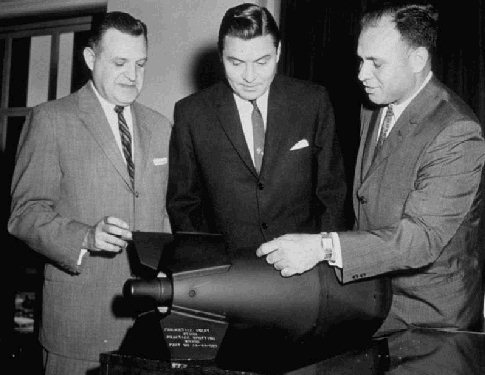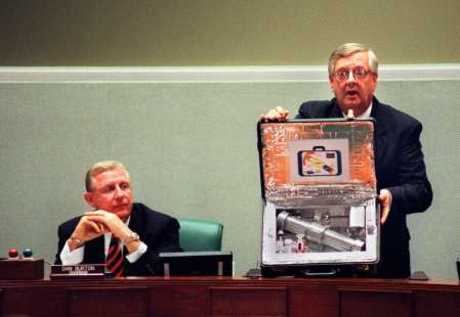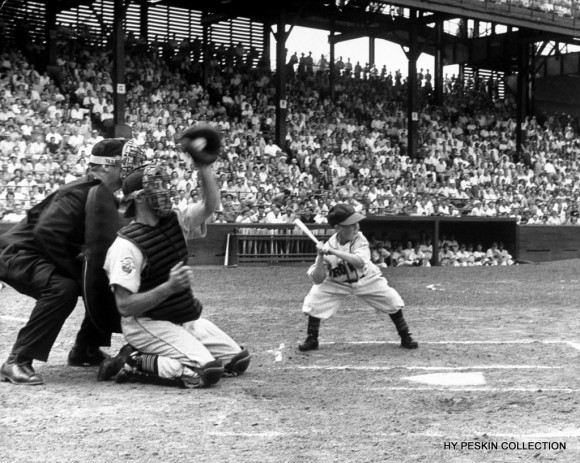I’ve been meaning to write something on my objections to a proposal by Crispin Rovere and Kalman Robertson to ban low-yield nuclear weapons.
Now, I should say that I think developing low-yield nuclear weapons seems like a pretty terrible idea. I am not much of a fan of what used to be called “plywood” (precision low-yield nuclear warheads) and bemoaned the loss of the admittedly flawed Spratt-Furse Amendment. (Although you should totally ask me about the Golan Lumber Company some time.) But I am not sure that a treaty banning nuclear weapons with yields of below five kilotons is a workable solution to the threat posed by so-called non-strategic nuclear weapons.
Rovere and Robertson present the proposal in a “new ASPI Insight paper, and in a longer companion study,” as well as a presentation Rovere made at CSIS PONI meeting. Rovere and Robertson have also hosted a discussion on the ASPI blog, with an outline of the proposal and exchanges with Malcom Davis (Davis|Rovere and Roberston|Davis again) and Rod Lyons (Lyons|Rovere and Robertson).
I don’t find the proposal very compelling. In fact, I think it’s probably a bad idea. But I didn’t want to write anything until I thought I could be constructive. Hey, there is a first time for everything!
The short version of my argument is that the nuclear weapons most likely to be used have yields in excess of the treaty’s five kiloton threshold, the treaty is so unverifiable that it will amount of a meaningless political commitment that no one takes seriously and that a much better solution to the development of “more usable” nuclear weapons would simply to bring into force the Comprehensive Nuclear Test Ban Treaty
The long version is after the jump.

Let’s step back and ask two questions: First, what problem are we trying to solve? Second, does Rovere and Robertson’s proposal solve this problem better than other, more likely outcomes such as entry-into-force of the Comprehensive Nuclear Test Ban Treaty?
1.
What problem are we trying to solve?
Rovere and Robertson start from the premise that nuclear weapons with yields below about five kilotons pose a “unique threat to international security.” If I understand them correctly, they believe that low-yield nuclear weapons are, or will be, more usable in some fashion. If we eliminate these weapons, we eliminate the most likely pathway to a general nuclear exchange. (There are other concerns relating to proliferation and theft that seem to be of secondary importance.)
I think this is wrong. In terms of utility, all things being equal, it is easier to use a smaller warhead against a target than a larger one. But all other things are not equal. Yield is a secondary factor in terms of utility. Consider the US program to develop a Robust Nuclear Earth Penetrator. RNEP would have been one of the most powerful warheads in the US arsenal, with a yield of up to one megaton — all the better to crush underground bunkers with, my dearie. The most “usable” weapons are the ones that can blow up targets. That means yields significantly larger than what was unleashed on Hiroshima and Nagasaki. Rovere and Robertson mention the 2001 Nuclear Posture Review, which expressed interest in weapons with “lower yields.” Notice that says lower yields, not low yields. No one in the United States is suggesting dropping sub-kiloton firecrackers on Fuhrerbunkers, the early-1990s insanity about PLYWD notwithstanding. IN case there was any confusion about that, our friend Linton Brooks cleared up:
This is a nuclear weapon. This is a nuclear weapon that is going to be hugely destructive and destructive over a large area. No sane person would use a weapon like that lightly, and I regret any impression that anybody, including me, has given that would suggest that this is going to be any easier a decision — I mean if this weapon were in the arsenal today, it would still be a hugely difficult decision for any president to even contemplate it. So I — the administration believes and I personally believe that this study should continue, but … I do want to make it clear that any thought of sort of nuclear weapons that aren’t really destructive is just nuts.
I general, I don’t think “low yield” nuclear weapons are more worrisome than other nuclear weapons — with the possible exception that the Russians might build something really, really irresponsible. I am actually quite skeptical that any country is, at the moment, stockpiling weapons with yields below five kilotons. There are a few exceptions worth mentioning.
First, I am skeptical of Pakistani claims to be developing nuclear artillery.
Second, there are some people who believe the Russians might be interested in developing nuclear weapons with yields below a kiloton. If Russia were building lots of artillery-fired atomic projectiles (AFAPs) or other low yield weapons, then I would almost certainly agree that we should discuss why that’s a bad idea. But I don’t think the evidence on Russian activities at NZ supports this hypothesis. We’ll come back to this.
Third, some US thermonuclear nuclear weapons contain a “variable yield” or “dial a yield” option to detonate at “the full yield of the two-stage weapon, the yield of the boosted primary, or the yield of the unboosted primary explosion.” Notice how I just quoted Dick Garwin there? We’ll come back to this, too.
I general, I don’t think “low yield” nuclear weapons are more worrisome than other nuclear weapons. In principle, man-portable nuclear weapons or nuclear artillery would be very worrisome. In practice, however, neither state is building these sorts of weapons.
2.
Does Rovere and Robertson’s proposal solve this problem better …
Now, obviously, if Russia is developing sub-kiloton nuclear weapons, that might be something we’d worry about. The problem is that I don’t know how we would verify Russia’s compliance with the treaty.
Rovere and Robertson tend to view verification as relatively unimportant because there are few deterrent benefits from a covert arsenal of low-yield nuclear weapons, as opposed to an overt one. I worry, on the other hand, that if the Russians build these things, they will do so not for deterrence but because they plan to use them. (Recall that, in the Cuban Missile Crisis, we did not know there were Soviet nuclear weapons already in Cuba. That would have been a very nasty surprise.)
In order to verify that no state possesses nuclear weapons of a certain yield, very intrusive measure measures would be necessary. The United States and Russia possess many, many, many nuclear weapons designs with yields below 5 kilotons they could deploy without further testing. The states party are simply not going to exchange the details of these designs nor allow inspectors to verify the design-types currently deployed. The US and Russia can’t agree to count warheads stored at bomber bases, let alone swap hydrodynamic codes. The entire endeavor of figuring out how to count actual warheads in a treaty is about protecting precisely the information necessary to verify a yield threshold. See the UK-Norway Initiative and the Princeton effort.
These comes through when Rovere and Robertson confront the problem of variable-yield warheads — thermonuclear warheads in which the yield of the primary is smaller than the full yield of the weapon:
Mechanisms for verifying the removal of low-yield settings from variable yield weapons will depend on the electronics used in these weapons and may be separately negotiated between the states that possess them.
That sound you hear is Frank Miller’s head exploding when he learns that we’re going to let the Russians examine all the electronics in our nuclear weapons.
When pushed, Rovere and Robertson entertain the idea of a completely verification-free political commitment:
If this proved impracticable then a simple agreement never to use or threaten to use nuclear weapons on yield settings below the minimum-yield threshold, coupled with an undertaking to phase out existing stockpiles as they approach the end of their ordinary replacement timeline, could be sufficient.
This doesn’t really solve the problem since the lowest yield setting is an integral part of the nuclear weapons design. We aren’t going to stop designing small primaries, although I suppose we could promise the Russians that the AFF set won’t have a dial-a-yield option. Still, they’ll have to take our word for it.
Rovere and Robertson mention the Spratt Furse Amendment, which prohibited the development of certain low-yield nuclear weapons. Spratt-Furse contained a large number of exceptions that permitted research on low yield nuclear weapons such as the development of new primaries.
Although I think the Bush Administration was wrong to seek repeal of Spratt-Furse, any prohibition on low-yield nuclear weapons by necessity had to legislate intention. The result was, as Linton Brooks complained, Spratt-Furse “leads us to the situation in which in addition to physicists and engineers, we have to have lawyers in thinking about technical development.” Now, I wasn’t terribly sympathetic to the nation’s weaponeers for the inconvenience they suffered, but Spratt-Furse was a difficult creature. In a treaty context, we would need a much better model than Spratt-Furse.
3.
… than other, more likely outcomes?
(such as entry-into-force of the Comprehensive Nuclear Test Ban Treaty)
If the problem really is that the Russians are conducting hydronuclear tests at Novaya Zemlya in order to develop sub-kiloton tactical nuclear weapons, there is a much easier solution than an unverifiable treaty to ban low-yield nuclear weapons. (After all, the crux of the problem is that we worry the Russians are already cheating on the CTBT.)
Why not simply work with Russia to bring into force the Comprehensive Nuclear Test Ban Treaty and, perhaps, agree to a set of confidence building measures to increase transparency at our test sites surrounding subcritical and hydrodynamic testing? (And don’t forget the Chinese!) This is a point that I’ve made over and over again.
Such an effort would be far from politically painless, but its a garden party compared to the nightmare of negotiating a global Spratt-Furse agreement.





my view is that a nuke is a nuke is a nuke. meaning that these distinctions mean nothing, make nuclear arms control more difficult, and attempt to distinguish between weapons never made to be used. at the same time, getting rid of everything is a really good idea, and there is really no good reason these days why Europe should not be a NWFZ.
If Pakistan’s claims of building TNWs or battlefield weapons seem incredible, then such skepticism should be good enough to eliminate any concerns on Nasr (Hatf-IX) and associated issues that are so profoundly obvious within international security and non-proliferation circles at present.
Jeff: a cogent and reasonable argument. And one also made by many officials in many nuclear-capable countries. Including, I believe, in some of the countries we don’t like. Which is good news.
And this part: “That sound you hear is Frank Miller’s head exploding when he learns that we’re going to let the Russians examine all the electronics in our nuclear weapons.” – I know, it’s only for the cognoscenti, but it just cracked me up.
(PS: we love you, Frank.)
We do love Frank! His head _should_ explode, as it would be a terrible idea to let the Russians verify design details like that.
If I could be in the room with only one person when he or she learned of this proposal, it would definitely be Frank.
And by “countries we don’t like,” you clearly mean the UK, right? (He says slathering peanut butter on his Freedom Muffin.)
A colleague is suggesting that, instead of Freedom Muffin, we use “croissants de liberté.”
Jeff, about “croissants de liberté”: most appropriate – or not? See the following (not a joke unfortunately): http://www.globalpost.com/dispatch/news/regions/middle-east/syria/130731/fatwa-against-eating-croissants-sharia-committee-syri
I understand the desire to maintain the distinction between conventional war and nuclear war. Once one nuclear weapon gets used (even a “small” one) this provides all enemies an excuse to employ many more and bigger ones, too. Crossing the nuclear threshold should not be made either “easy” or tempting.
Nevertheless, I think the opposite limitation on size would be more useful. We should limit both numbers of nuclear weapons and their maximum yields. Given the world’s continued reliance on nuclear deterrence rather than disarmament, we must be prepared for the probability of deterrence failure that results in nuclear war. It is best that the destruction from such nuclear war be limited as much as possible.
What would it take to ensure that all nuclear weapons do not exceed some maximum yield? I have in mind such features as quantity and type of fissile materials, and maybe some observable design features, but probably not electronics. What limit(s) would be capable of verification? 50 kt? 200 kt? 1 Mt? How would this be done?
If arms control is ever successful in reducing total numbers to a much smaller number, I am much more concerned that we may end up with 100 3-megaton monsters, less concerned about 100 mini-monsters. Size does matter. A lot.
Jonah states that “Once one nuclear weapon gets used (even a “small” one) this provides all enemies an excuse to employ many more and bigger ones, too.”
As I challenged Rovere and Robertson in my second response to them on the ASPI Strategist (http://www.aspistrategist.org.au/low-yield-nuclear-weapons-do-have-utility/), “why?” Obviously nuclear first use invites a retaliatory response, but too often the debate over the utility or non-utility of nuclear weapons ignores the rationality of national command even during nuclear war. Nuclear first use would of course increase escalatory pressures, but would either side really embrace irrationality and rush mindlessly toward mutual destruction? Or would they seek to contain a nuclear conflict at the lowest-level possible by practicing intra-war deterrence, and employing all possible measures to bring about early war termination? I’m not convinced that a small number of low-yield non-strategic nuclear weapons used on the battlefield automatically leads to a slippery slope to MAD providing both actors maintain positive control over nuclear forces, and are rational. MAD benefits no-one – there are no victors – but early war termination even after limited nuclear use can avoid such an irrational outcome.
Of course, much depends on what actors we are considering and which nuclear scenario is in play. A India-Pakistan conflict would see Pakistani nuclear use in response to an Indian conventional attack leading to Indian nuclear retaliation. But would India strike Pakistani cities, ensuring Pakistani retaliation against Indian cities, and ultimately mutual destruction? Or would they strike Pakistani nuclear forces at the tactical level, leaving open the opportunity for war termination? In the pressures of a nuclear environment, national command can make the mistake of giving into emotive, irrational urges, and risk mutual annihilation, or it can seek to remain focused on minimising risks even after nuclear first use.
I accept, I cannot know what course of action Indian and Pakistani leaders would choose in a crisis. Nor do I necessarily support a view that nuclear war is winnable – it is not. But I challenge those who argue that nuclear first use must automatically lead to MAD.
Just to clarify, I do not predict that a first use of nuclear weapons will necessarily result in MAD. I only indicate that a threshold is breached, making MAD more likely. Whether or not the result is MAD, the second use is likely to be worse than the first use, the third worse than the second, etc., until somebody gives up or a cease-fire is agreed to.
Two opponents may tacitly agree to no-nuke-use, so long as the opponent also refrains. Once this threshold is breached, it is difficult to establish a new rule that both sides can tacitly accept. For example, distinguishing between civilian and military targets, or between tactical and non-tactical uses of nuclear weapons, or even the yields of nuclear weapons, can get both fuzzy and disputatious. Even though it would be rational for the two opponents to agree (tacitly or explicitly) to some new limitation (somewhere between no-nuke-use and bomb-anything-you-can), it could prove next to impossible to establish and enforce this new limitation during the middle of a fast-paced war.
For reasons stated by others on this web page, requiring a minimum yield size may prove impossible to verify. I instead suggest a maximum yield size. In combination with limits on numbers of nuclear weapons, this would limit the damage from any nuclear war. Is a maximum yield limitation for nuclear weapons capable of being verified?
Jonah writes:
Is a maximum yield limitation for nuclear weapons capable of being verified?
It would be difficult, but doable.
One could imagine a variety of thresholds. One might be “no secondaries”, so nothing more than boosted fission weapons. One could X-ray and verify that a weapon casing contained only one seriously dense component assembly, not two. This could be very low-res inspection.
Another might be secondaries but some limit on volume; the rough yield from a liter of HEU or LiD secondary is known, so the total secondary volume can tell you maximum credible yield. This would take somewhat more resolution.
Trying to determine / verify the precise materials makeup without taking a device apart is hard.
“The most “usable” weapons are the ones that can blow up targets. That means yields significantly larger than what was unleashed on Hiroshima and Nagasaki.”
Daryl Press and Keir Lieber would agree with the first sentence but probably disagree with the second, as they also ascribe great value to weapons that can minimize fallout. In their Technical Appendix for “The Nukes We Need,” their FIGURE 3 purports to show a sweet spot–yields well below 5 kt–where sufficiently accurate airburts can both take out Chinese silos and produce minimal fallout.
http://www.dartmouth.edu/~dpress/docs/Press_FA-2009-Appendix-12-post.pdf. Other than the initial rejoinder by Hans Kristensen, Matthew McKinzie and Ivan Oelrich, I haven’t seen pushback against that limited part of their analysis.
Your exposition of “what problem are we trying to solve” acknowledges that the U.S. has ultra low yield, “dial-a-yield” warheads, but doesn’t speak of that as a concern in any way. I’d bet Press and Lieber think the U.S. IS MUCH more likely to use them than anything else we got, because they believe that the U.S. CAN finesse threats or the actual use of such weapons and in some sense manage escalation.
I’m curious why you didn’t even MENTION this argument–which is, at least, a serious and sincere one–why very low yield warheads may be “more usable.”
The problem with Press and Lieber’s argument is quite simple – there is no “sweet spot” – if you want to get some serious overpressure on the ground, the fireball will touch the surface. They don’t say how they calculated the HoB needed to avoid fallout, but if you take Glasstone and Dolan, they have a figure (2.121, p. 68) that gives the fireball radius for 20 kt explosion as 800 ft. Scaling this down to a 0.1 kt gives you about 140 ft – roughly twice than what the HoB Lieber and Press assumed for their 0.1 kt weapon.
No to mention that for hard targets it’s not the air overpressure that kills – it’s the seismic wave in the ground. Air overpressure is used as a reasonably convenient proxy for kill effects, but I’m fairly certain that ICBM silos would survive an air blast. Definitely a low-yield one.
The other problem with Press and Lieber’s argument is that they presume that destroying Chinese missile silos is a matter of overriding importance, when most Chinese missiles aren’t deployed in silos any more.
The other other problem with Press and Lieber’s argument is that they dismiss the possibility of conventional counterforce targeting with little more than an assertion that the Chinese can jam GPS and without GPS the United States couldn’t possibly aim any non-nuclear weapon precisely enough to take out a silo. I can think of three solutions to that problem in about as many seconds.
The meta-problem with Press and Lieber’s argument is that it presumes there is a credible scenario in which a preemptive nuclear strike against China is required but significant civilian casualties are intolerable. I rather suspect ~1.3 billion Chinese will take issue with that.
John, Could you clarify whether conventional missiles are currently able to take out hardened missile silos (Chinese, Russian, or American)? Or is this future (but foreseeable) technology?
What are the three alternatives to GPS?
Would the conventional weapon’s explosion need to be bigger than 0.1 kt, as Pavel suggests above?
The scenario Press and Lieber were contemplating was a conventional counterforce strike using B-2s, so bombs rather than missiles. The United States maintains three general types of bombs capable of destroying hardened targets such as missile silos, using GPS guidance, laser guidance, and optical guidance. At present, I believe the B-2 only uses GPS-guided bombs, but if this ever becomes a crippling limitation, equipping the B-2 to deliver laser or optically guided bombs would be much easier than developing and fielding an entirely new class of tactical nuclear weapons.
The third alternative would be to retain the GPS-guided bombs, but equip the B-2 bombers with WAAS (Wide Area Augmentation System) transmitters calibrated by optical alignment with mapped landmarks in the target area. This would provide a locally-sourced GPS signal with greater power and possibly greater precision than the satellite signals. This is a well-established technology, long used to support e.g. precision instrument landings by aircraft flying in low visibility. It would obviously compromise the stealth characteristics of the B-2, but only for the few minutes that the bombs are actually falling.
At present, there are short- to medium-range missiles with laser or optical guidance and hard-target penetrating warheads, but nothing with intercontinental range and nothing with the 1000-kg class penetrating warheads of a GBU-15 or GBU-24, so it would probably come down to gravity bombs if we wanted a conventional silo-busting capability tomorrow. Ten to twenty years out, the United States at least tentatively plans to deploy long-range missiles with precision conventional warheads, and those could be designed to bust silos if this were seen as a mission requirement.